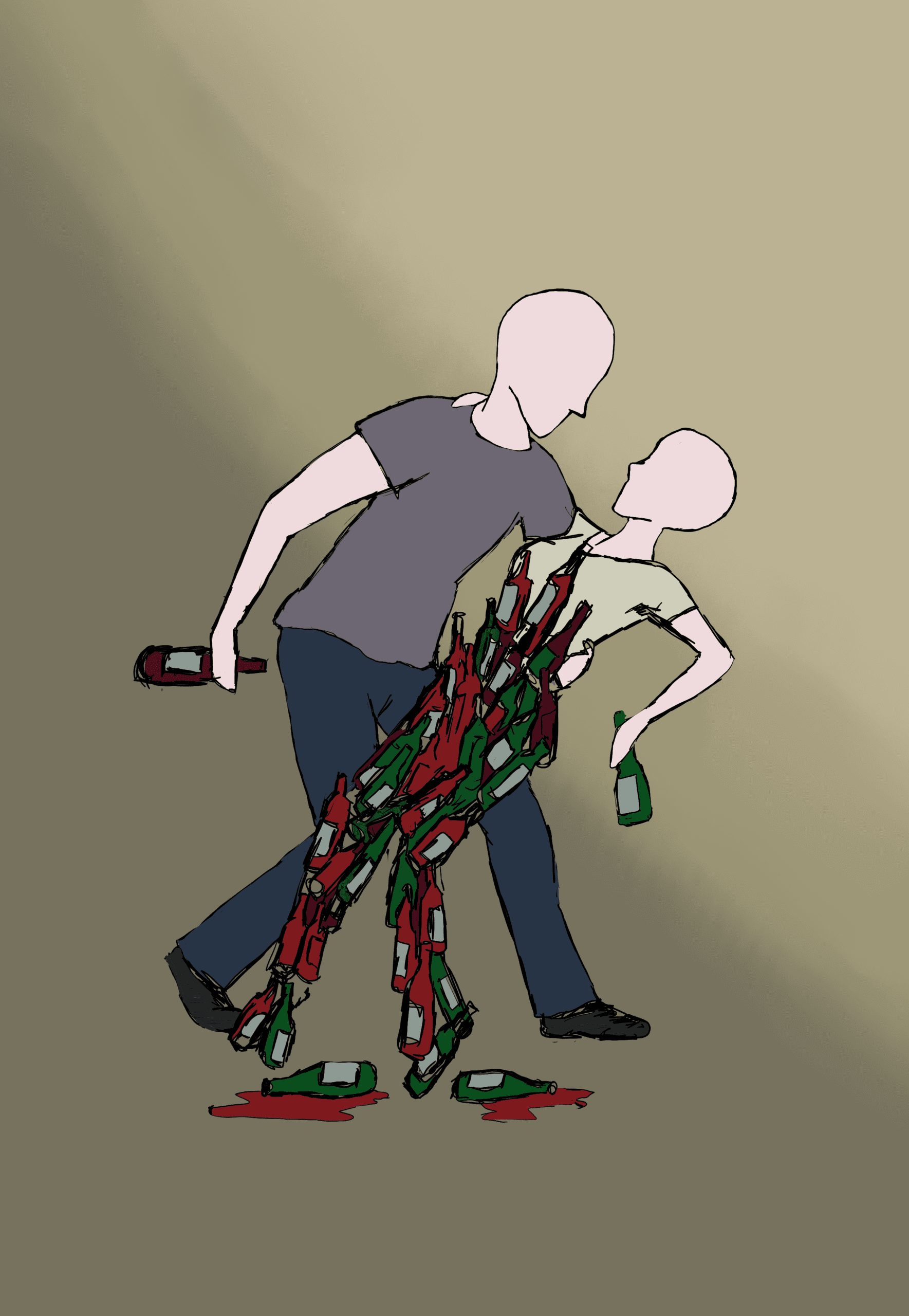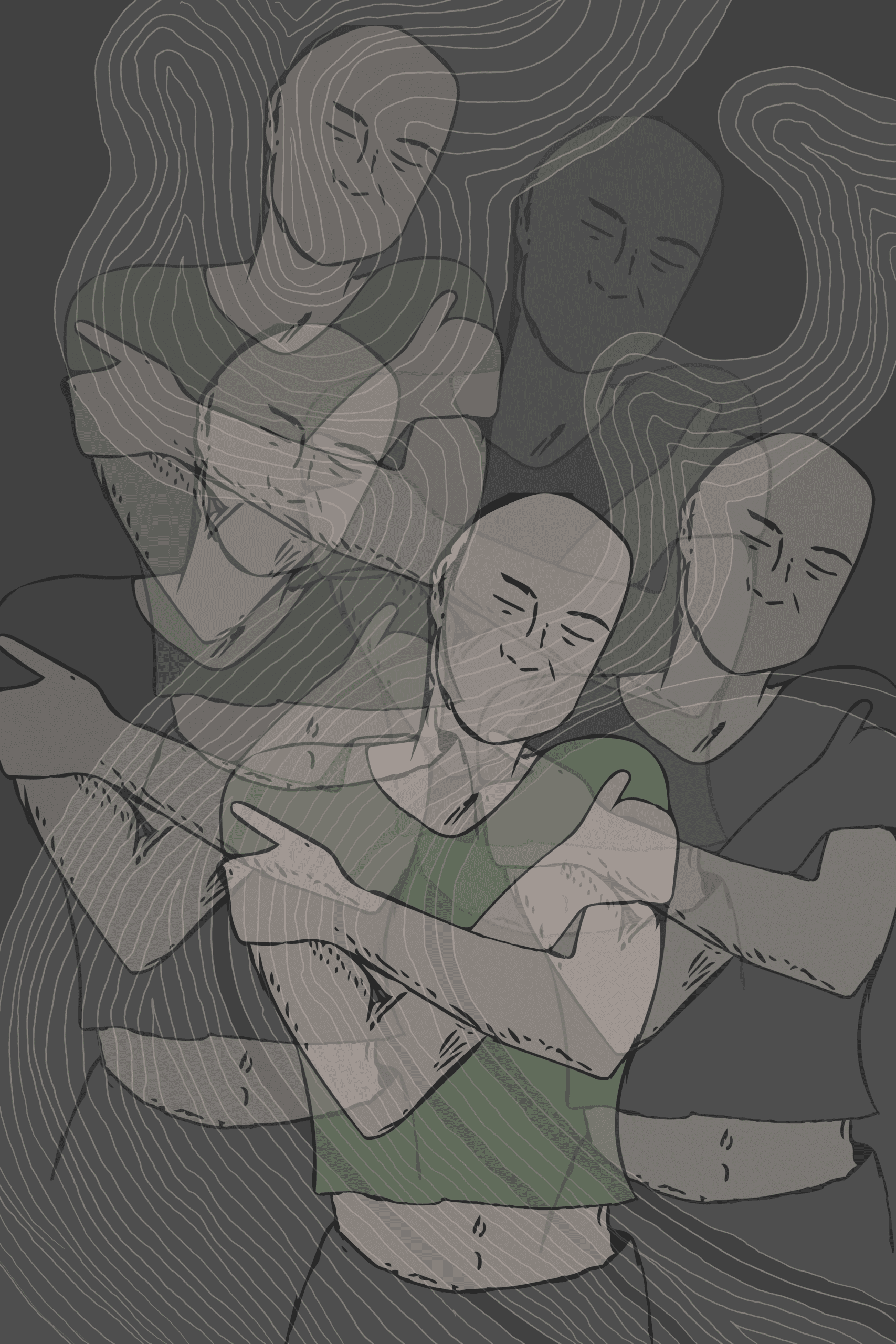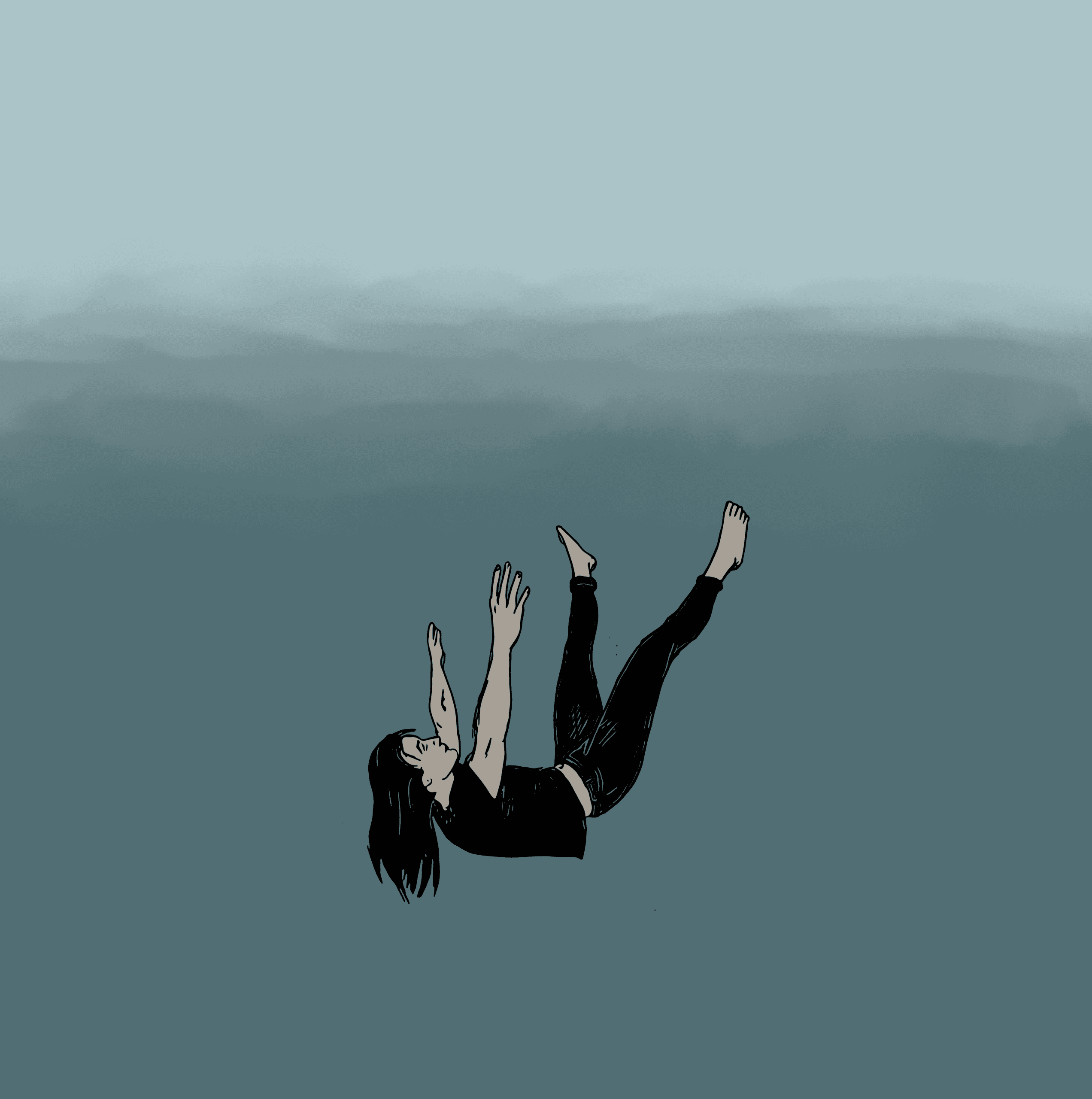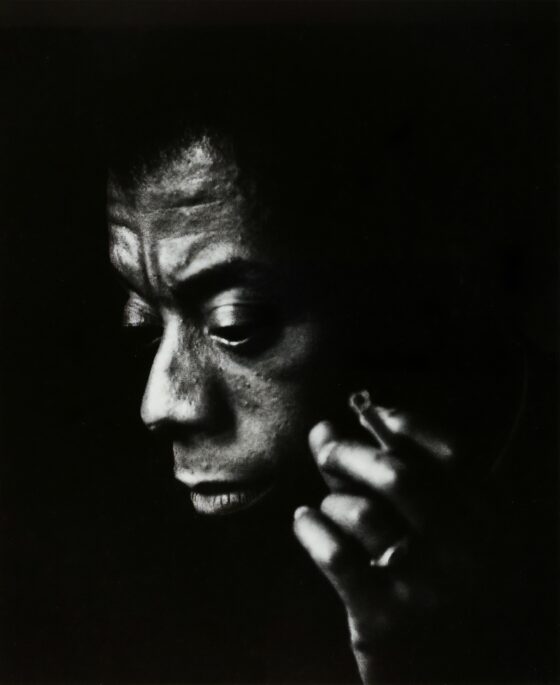
A week before my thirty-first birthday party, I punched a wall. Not thin plaster; cement. I was angry so I punched it a few times. I wanted but failed to break my hand. I wanted to break my hand so I could go to my next doctor’s appointment (the eighth in three months) and have something to show. “Look. It’s broken. Fix it.”
The party was small, my husband’s idea, immediate family only. My two-year-old nephew peed on our brand-new rug, after which we ate mussels and home fries, neither prepared by me. I lost control of my neck muscles at the dining table, head lolling, and everyone pretended not to notice, except my mother who kept a tight, panicked grip on my thigh. Later, after cake, I maneuvered around the living room using the walls for leverage because my legs refused to carry my slight frame without support.
After the party ended, we made a video to send to the last doctor I’d seen: a neurologist. During the visit, after I had carefully read out the list of symptoms I’d written on a sheet of notebook paper, he’d said, “Could be lots of things. Let’s keep an eye on it.”
The recording lasts less than a minute. I look drained, the skin under my eyes gray and slack. My husband, who is holding the phone, directs me to walk from a chair to a couch toward my father. Instead of moving synchronously, my legs buckle outwards, trembling, with no fixed center of gravity. My upper body improbably, absurdly, bounces with each step: a jack-in-the-box. I collapse into my father’s arms. He stares directly into the phone camera, expression grim.
The neurologist emailed back a few hours later: Take her to the hospital.
The first time my body quit on me was when we were walking to a bus stop in Washington, DC’s Georgetown neighborhood, amid quaint storefronts and manicured cobblestones. It was October, a few months before my thirty-first birthday. My French husband and I had just purchased an overpriced rug (following a brief argument) and a bottle of red wine. We were walking to a bus stop, I was upright, no I wasn’t. My husband dropped the rug and caught me, wine intact, before my head hit the ground. People gathered. Stared. A police officer who happened to be nearby asked me questions to determine my sobriety. The EMTs arrived. “Standard policy, ma’am,” the officer told me. I sat in the back of an ambulance while my blood pressure was checked. “Your wife might be dehydrated. Or overly fatigued. Sir, I suggest you all take a cab home.”
This became an anecdote—I the damsel in distress and my husband the hero. Of course, the Frenchman saved the wine, too. We shared the incident with a few friends, my parents; everyone laughed. I laughed too. It was funny, until it wasn’t.
The dizziness didn’t take long to creep back, a gray mouse against a gray wall in the subway. You whip your head around to make sure you really saw it, but it’s already gone. I’m dizzy, no I’m not. I’m standing, no I’m not. “Body,” I would ask, “are you making this up?” “Body, are you okay?”
After a few weeks, the creeping dizziness felt more like a military assault. At first, it struck only in public places. “Body, are you dehydrated?” “Are you overly fatigued?” Then at home, in front of the computer. “Body, is the screen too bright?” Then watching television, making dinner, anywhere, everywhere. Mice have short gestation periods; they reproduce rapidly.
With the dizziness came sporadic numbness in my right arm, a fleeting and unpredictable inability to maintain my head erect, frequent falls, many bruises. A sudden feeling of all the blood exiting my lower body. It was like wearing a pair of jeans that are way too big, so they collapse in a puddle at your feet. Except my legs were the jeans.
There’s a spectacular fucked-up-ness to wanting a brain tumor. Okay, not a tumor but some mild neurological or cardiac condition—anything as long as it’s not nothing.
After three and a half months of mice-chasing, I was given (gifted?) an authoritative diagnosis in the neurological ward of Georgetown University Hospital. In a tremendous act of self-restraint, I did not Google it at the time.
Good thing. Non-physiological astasia-abasia doesn’t mean much at all, in terms of a diagnosis. The last two words signify an inability to walk or stand in a normal manner. The first two that there is no identifiable physiological cause for your symptoms. Meaning it’s in your fucking head.
Emoting—yelling, fighting, crying, whatever—is an acquired trait: a behavior that helps an organism survive. I wasn’t born with this ability. Instead I inherited a predisposition for silence, calm, poise, for being a “good girl”; the descriptors change but it’s all the same. Whenever I held myself in, my mother, whose family roots extend to Norway, would say, “There’s the Scandinavian side of you.” This wasn’t a compliment or encouragement, just an observation. She holds herself in, too, as did her mother and her sisters and so on. Our restraint is a multi-generational legacy.
My father, who is Tunisian, is more emotive. But there is an unspoken pride in forbearance in him as well.
My parents cry rarely. Still, my mother cried in relief when the doctors ruled out multiple sclerosis, a tumor, brain cancer. Who knows, my father might have cried, too, in the corridor outside my hospital room.
I didn’t cry. I held myself in. Old habits, and all that. Though the main reason was that my relief was short-lived. The thing is, if you were to find out your body was failing you on the most fundamental level because your mind was making it, would that come as a relief? Or would it scare the shit out of you?
I was discharged from the hospital with two specialist referrals, firm instructions to continue the anti-depressants I had been taking for ten years, and “non-physiological astasia-abasia” playing on repeat in my brain like an odd, terrifying jingle.
Both my new doctors were men, unsurprisingly perhaps. The first, Dr. T, taught me to walk again. Regardless of whether the root of my ataxia (the medical term for unsteady walk) was mental or physical, my body had to relearn to balance. With three physical therapy sessions a week, at a copay of $50 per session for a duration of eight weeks, this cost me $1,200. The walker was fully covered by insurance, however. I named it Petra because I thought that “fucking Petra” had a nice ring to it. As in, “me and fucking Petra will make it to the elevators today.”
My PT consisted of “adjustment compensation”: the body is forced into positions of imbalance so that it learns to adapt and thereby regain its natural equilibrium. For example, Dr. T might strap a canvas holster around my torso (if you’re imagining a modified straight jacket, you’re not far off) and slowly unspool the leash (“it’s not a leash”). Maintaining a firm, two-handed grip, the not-leash taut, Dr. T would propel me in circles around a large room populated by exercise mats and massage tables, like a child at the edge of a careening merry-go-round. If it was too crowded, we would move to the adjoining hallway, along whose length he would expertly unspool me before snapping me back to him, breathless and reeling. “Again,” he would say.
I didn’t mind these sessions. I didn’t feel humiliated or infantilized, but rather grateful for something I could do, instead of think about. I was less concerned with the optics of my circumstances from a feminist angle, so clear to me now, and more focused with the diagnostic reality: somehow, supposedly, I’d done this to myself.
“Body, are you mad?” “Body, I’m so sorry.” “Body, please come back to me.”
After two months, I could walk normally, with occasional relapses.
The second man is more important.
I liked Dr. L because he didn’t like me. By that I mean he was intrigued by my medical condition but indifferent to me as a person. I wasn’t his object of lust or his perfect woman or his train wreck or anything. I was just a mouse in his maze.
On the day we met, there was no chair in my hospital room apart from the one I was sitting in. But there was a wheelchair, which I offered to him without taking into account his stout physique. Still, he sat, and from this undignified pose, elbows awkwardly tucked back, he calmly explained that my mind was making my body sick, but that it was okay; he could fix me.
Dr. L isn’t much older than me, but I was told he was already a genius in his field. He specializes in conversion disorders, which are defined by the Genetic and Rare Diseases Information Center of the National Institutes of Health, as:
a disorder in which a person experiences blindness, paralysis, or other symptoms affecting the nervous system that cannot be explained solely by a physical illness or injury. Symptoms usually begin suddenly after a period of emotional or physical distress or psychological conflict.
Dr. L explained that my ataxia may have initially been a physiological reaction, meaning it had an external cause whose symptoms provoked such acute psychological stress that they, the symptoms, continued after the external cause dissipated. By way of example, he told me about a study of epileptic patients who suffered from both physiological and psychogenic seizures:
A female subject was given an electroencephalogram, electrodes attached to her scalp with colloidal glue to detect abnormal brain waves. She experienced a seizure, a black tide swelling across the screen. Ten minutes later, she had a second seizure, visibly of similar intensity—only this time the sea was calm. Anxiety caused by the first episode brought about the second one.
Even with a limited academic understanding of psychology, the vestiges of an intro college course, I could understand this: the brain reacted to trauma and then, anticipating and preempting further trauma, reacted in a void. The subject’s mind was shying away from mice that were no longer there.
“So she was crazy?” I joked.
Dr. L, who never joked, responded, “We don’t use terms like that.”
Dr. L in fact believed that my conversion disorder was caused by a trigger event that had revived past, repressed traumas. Except that nothing significant happened to me that year. I got promoted at a journalism job I hated; I regularly drank half a bottle of red wine in one sitting; my husband and I moved from New York City to Washington, DC, near my family, into an apartment with lots of natural light, and hardwood floors. No triggers. And the old traumas were well in the past.
March 28, 2003, was the worst day of my life. At 6:30 a.m., two nineteen-year-old boys named Dave and Chris, who lived in the same freshman dorm as me and my roommate, stormed into our room, which we usually left unlocked. I grumbled something like, “Oh for fuck’s sake, can’t it wait?” and Dave said, “No it can’t. Greg’s dead; he jumped out the attic window.” The attic was two floors above us, and an early morning jogger had found the body.
This was the year Herbal Essences shampoo was big; all the girls were using it. My mother picked me up after the funeral. She looked like she wanted to cry, but she didn’t, hugging me very hard instead. Later, she would tell me that she would never forget how my hair smelled, my head clasped to her chest: a shock of flowers.
A few years later, another spring, another worst day: March 14, 2009. I was living in Lyon, France, with my then-boyfriend-now-husband and got a phone call from one of my best friends, state-side. She said, “You should sit down,” and then stampeded over my response: “Kate’s dead. She was murdered.”
I didn’t go to Kate’s funeral because I had used all my savings on the move abroad and couldn’t afford the plane ticket home and was about to start a new job. But really, because I couldn’t and so I didn’t.
I said little about Kate or Greg in the weeks, months, years that followed their respective deaths. I had lost a good friend and a best friend, and no, I didn’t want to talk about it. I held onto a few (literal) scraps—a note handwritten in green ink, a few photos, “in memoriam” newspaper clippings I never read—and filed them away in one of those cheap rectangular boxes from the Container Store made to hold things that have no place.
Dr. L told me that he thought I had never processed my grief. That bottling up my emotions in general had likely fostered a lasting sense of isolation. That I am a habitual and excellent liar. Because hiding things from one’s loved ones out of fear or shame or because you don’t want them to worry is, apparently, lying.
When I was in therapy, I didn’t know that hysterical neurosis—the first mental disorder specifically attributed to women, its cause initially deemed demonological and later biological—wasn’t removed from the Diagnostic and Statistical Manual of Mental Disorders (the DSM) until 1980. I didn’t think about my gender during our sessions; I just wanted my body back.
I told Dr. L that I’d never been abused or abandoned, and that I had a strong support system. That my parents, though emotionally reserved, are physically affectionate; my whole life I have been touched, and that with love. That I had a mostly happy marriage to an affable, charismatic man who had always been encouraged to express his emotions, and in turn encouraged me to express mine. That yes, there was a long family history of mental illness—chronic depression, bipolar disorder, anxiety disorder, eating disorder, substance abuse, self-harm, attempted suicide, successful suicide—but that of course these biological traumas were not all mine. It had surely been something else that so swiftly knocked me from my footing.
I told Dr. L that I rarely spoke Greg and Kate’s names. Only when I got really drunk or stoned, alone on a sad high, or with my husband on the anniversaries of their deaths, lighting Ikea votive candles in whatever home we happened to be living in. These rituals were safe. Maybe easy is the better word. They took the place of grieving, of thinking about the worst days. And so of course I never felt better.
A few years ago, I discovered the existence of Lichtenberg figures: telltale and intricate scars left by lightning strikes. They provide an immediate, irrefutable diagnosis—if one is needed—that you’ve been struck. Enticed by this notion of trauma being visible on the outside, I’ve imagined the deaths of Kate and Greg as Lichtenberg figures blazoned across my skin, communicating my grief so I wouldn’t have to.
I know my metaphor is flawed. Lichtenberg figures are typically painless and fade after a few days. The trauma is only skin-deep, and quickly erased. Greg died almost two decades ago, Kate a few years later. I have no physical scars of those losses, no scabbing over to show the wounds have closed or, conversely, no angry inflammation to indicate they’re still healing.
And yet, one day, I started falling.
I think it might have been the small, banal traumas that wore my body down in the end, all the holding back, the protecting, fearing, hiding, and lying, the being too perfect or too manic or both, of being no one or too many or too much. Do I sound hysterical?
After eighteen months of therapy, I asked Dr. L, “Do we have to keep looking for some big trigger event?”
Like I said, nothing happened that year.
“Couldn’t this have occurred because of an accumulation of perfectly mundane, perfectly common stressors?”
Dr. L shrugged.
A few friends saw me fall. Not many because I eventually stopped leaving my apartment. Recently, I told a new friend, a woman, the whole diagnosis, the whole my-mind-made-my-body-sick.
“You got a second opinion, right?”
I shook my head.
“Don’t tell me you let some male doctor convince you that you’re crazy?!”
I shrugged.
I didn’t know how to express my deliberately cultivated apathy. How, in the immediacy of learning how to walk normally again, I felt that I couldn’t afford to linger on a possible “trigger” event or, more alarmingly, the possibility that my diagnosis was incorrect or gendered. If I let my mind wander to—settle into—those places, I was certain the gray fog would return. My legs would fail me again.
It was easy to trust my doctors because under their care, my symptoms went away. Dr. T got me back on my feet in a matter of weeks. I didn’t miraculously shed my bad habits during my sessions with Dr. L, but I started to recognize what I wanted or needed and made efforts to express it. To identify where it hurt and express that, too.
When I did relapse, it was during periods of acute stress. This made sense to me. Body + stressor = reaction. Push a thing hard enough and it will fall. Push a thing hard enough and it might push back.
But though I don’t question my diagnosis, I remain uncomfortably aware of the millennia-old blight of a narrative that lurks beneath. Morose wandering uteruses (Hippocrates’s explanation for hysteria); barefoot virgins and widows burning at the stake, their heads shaved; pale Victorian women being handed smelling salts to nudge the wily womb back in place, that condescending nod—you know it too, don’t you?—and rushed doctor’s visit: “Have you been under a lot of stress lately? Let’s keep an eye on it.”
Hysteric. Witch. Bitch. Crazy. You don’t have to say a word to give it power.
Today, I still accept my diagnosis. I just wish that I had asked Dr. L: how many of your patients are women?
It would appear that you don’t recover from a conversion disorder. Mine still haunts my medical record: “unresolved condition.” I assume this is because the physical symptoms may go away, but there’s no way to objectively determine when the psychological conflict has been resolved.
I refrained from writing about my diagnosis for a long time, as if doing so would trigger the jack-in-the-box, like how saying “Bloody Mary” (another hysteric) three times before a dark mirror is said to summon her ghost.
I refrained from telling people because I was angry and embarrassed and ashamed—that crippling triad of emotion familiar to so many. So many women, is what I mean to say.
Angry: because I thought accepting my conversion disorder equated to reinforcing a skewed narrative of female illness, emotion, and ultimately, weakness.
Embarrassed: because when Greg and Kate died, nothing actually happened to me. There’s a spectrum of grief—culminating with the loss of a parent, partner, or child—and I didn’t think mine amounted to all that much, comparatively.
Ashamed: because I was convinced that I was weak, physically and mentally.
Those emotions have receded, though they’re still there, in diluted form. It took a while, but I’ve learned that a person—a woman—can both hold herself in and pour herself out. That the world can and will go gray, for a long time even, before brightening to white. That body and mind are inextricably linked, and when the former falters, the latter may be your best guide.
Maybe once or twice a year, I sense the dizziness creeping back. A blur of gray against gray. My first reaction is panic. “Body, did you see that?”
Then I remember: My body is my ally. It is the teller of truths. “Body,” I say instead, “I’m listening.”
***
The National Suicide Prevention Lifeline offers free, confidential crisis counseling twenty-four hours a day, seven days a week, three hundred and sixty-five days a year. You don’t have to be suicidal to call (1-800-273-8255). The Lifeline also offers services for people who are deaf or hard of hearing (1-800-799-4889) and people who speak Spanish (en español: 1-888-628-9454). People who are transgender can also call the Trans Lifeline (U.S.: 877-565-8860; Canada: 877-330-6366). – Ed.







